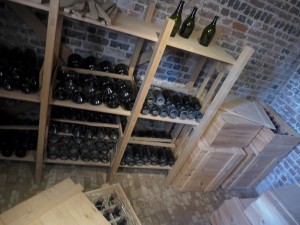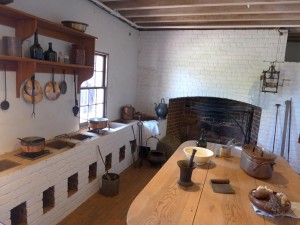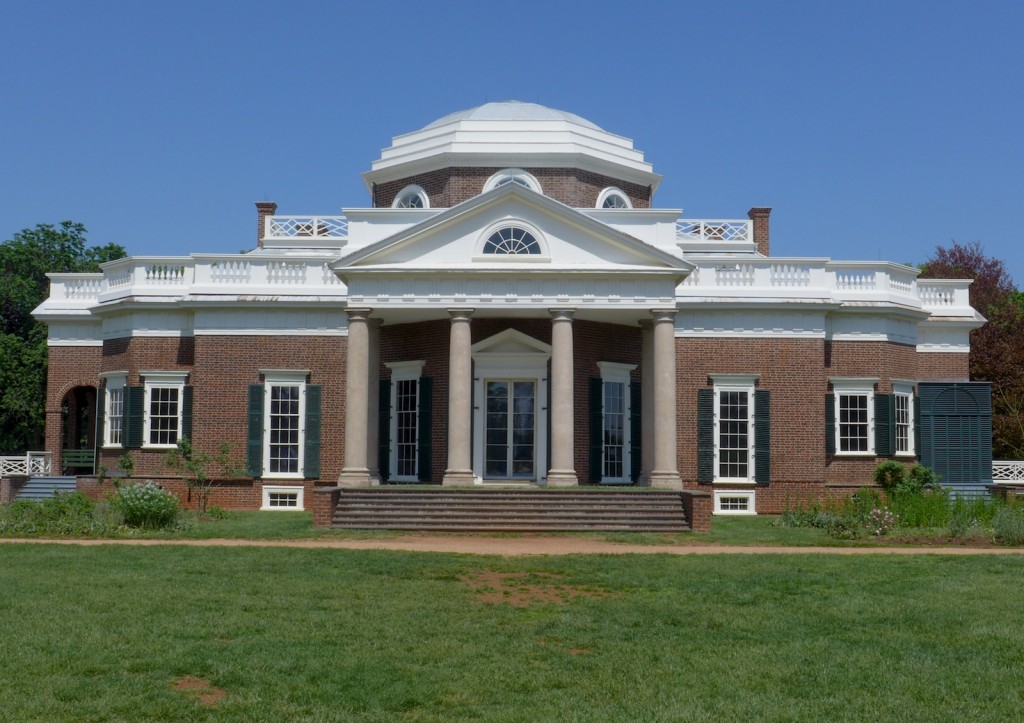Everyone knows this image, because this view of Thomas Jefferson’s home at Monticello/VA is on back of every Nickel (the US 5 cent coin). However, if you’ve never been there then neither that nor anything else can prepare you for the experience of visiting this astonishingly well preserved home of one of the great movers and shakers of the late 18th and early 19th centuries. In spite of all the differences between them, it reminded me of visiting Goethe’s house in Weimar (they were contemporaries, and although Goethe was less of a politician and more of a writer than Jefferson both were polymaths and room-filling personalities). Jefferson plays a much more important role for the contemporary sense of American national identity than Goethe does for Germans. Of course, the reason for this is that Jefferson drafted the American Declaration of Independence, which is one of the world’s most important political documents.
I’m a Brit, but certain lines of that document were etched into my memory during high school history lessons back in the early 1970s, the approaching American Bicentennial having temporarily changed the history curriculum at my school. “We hold these truths to be self evident: that all men are created equal; that they reendowed by their Creator with inherent and inalienable rights; that among these are life, liberty, and the pursuit of happiness…” (If I got it right, these are the exact words of his daft, rather than the final text unanimously passed by Congress on July 4th 1776). Much later, I became aware of the fact that for Jefferson the pursuit of happiness also meant wine, and that during the late 1780s when he was the American ambassador to France he travelled to the Rhine and was greatly impressed by the Riesling wines he tasted there. That was the official reason for Riesling Road Trip’s visit to Monticello.
 After he became the third President of the United States in 1800 Jefferson became a kind of unofficial ambassador for wine and culinary culture in the new republic, something he continued after his retirement to Monticello in 1809. His typical daily wine consumption was three or four glasses with dinner. In his dining room there was equipped with a wine dumb waiter which hoisted fresh wine bottles from the cellar and the empties back down. Unfortunately, photography isn’t allowed in the dining room, but pictured above left is the (recently restored) wine cellar. There was also a cellar where wine bought in cask
After he became the third President of the United States in 1800 Jefferson became a kind of unofficial ambassador for wine and culinary culture in the new republic, something he continued after his retirement to Monticello in 1809. His typical daily wine consumption was three or four glasses with dinner. In his dining room there was equipped with a wine dumb waiter which hoisted fresh wine bottles from the cellar and the empties back down. Unfortunately, photography isn’t allowed in the dining room, but pictured above left is the (recently restored) wine cellar. There was also a cellar where wine bought in cask  was bottled, and a separate beer cellar. The kitchen, pictured right was very modern for its time. The food prepared here was described by Daniel Webster in 1824 as, “half Virginian, half French in style, in good taste and abundance.” There is no trace of puritanism in any of this, much less of the American temperance movement that only developed after Jefferson’s death on July 4th 1826. Jefferson was against drunkenness though, in fact he saw promoting wine consumption as the answer to this problem.
was bottled, and a separate beer cellar. The kitchen, pictured right was very modern for its time. The food prepared here was described by Daniel Webster in 1824 as, “half Virginian, half French in style, in good taste and abundance.” There is no trace of puritanism in any of this, much less of the American temperance movement that only developed after Jefferson’s death on July 4th 1826. Jefferson was against drunkenness though, in fact he saw promoting wine consumption as the answer to this problem.
Something which impressed me very much about Monticello is that while this is some kind of national shrine (how could it not be that given the man’s achievements?) Jefferson’s personality is presented without conscious idealization, and the contradictory aspects of his thinking and behavior haven’t been air-brushed out. The most important of these was his long-term sexual relationship with Sally Hemings, one of the roughly 130 slaves he owned (over his entire lifetime he owned about 600 slaves). Genetic analysis of her descendants makes it look certain that he fathered her four children. In some respects, this inter-racial relationship looks very modern and was clearly a fore-runner of a vital aspect of contemporary America. However, Sally Hemings was not one of the seven slaves that Jefferson freed during his lifetime. That isn’t so easy to square with, “all men are created equal,” and also might be considered to contradict Jefferson’s modernism in so many other areas of life. It reminds us that nothing in this world is entirely black or white (no pun intended), and this simple observation that is as old as the hills is also part of the Riesling Spirit. The BEST WHITE WINE ON EARTH peacefully co-exists with all the other wines on the planet, and is an example to us all.
For more information go to: http://www.monticello.org
PS My condolences to the Faller family of Kaysersberg/Alsace. Domaine Weinbach’s winemaker Laurence Faller just died of what appears to be a heart attack. She was just 47. When I return to New York Wine City I will drink a bottle of Domaine Weinbach’s Riesling Grand Cru Schlossberg “Cuvée Ste. Catherine” in her memory. RIP


![120114_riesling_global_RZ [1600x1200]](http://www.stuartpigott.de/wp-content/uploads/2014/05/120114_riesling_global_RZ-1600x120014.jpg)